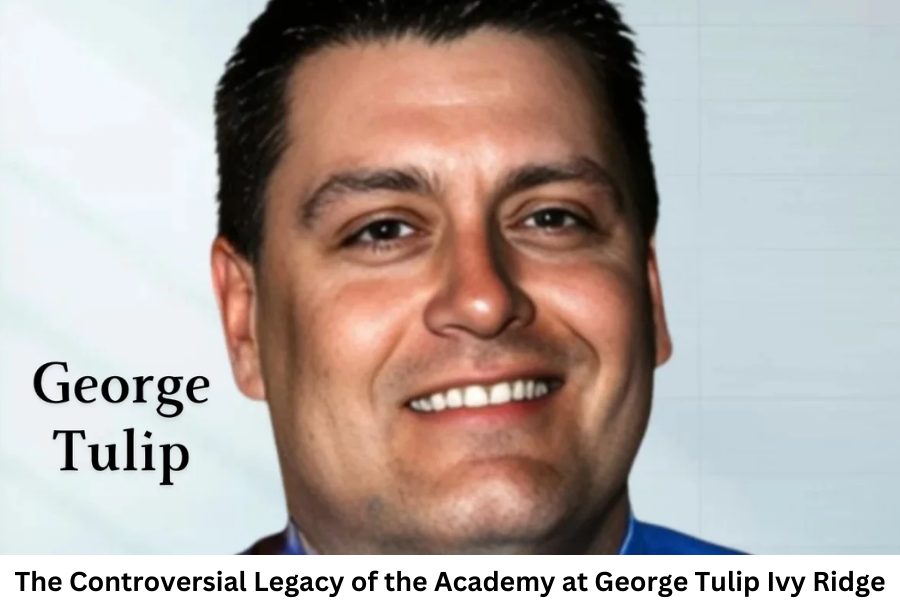Introduction
The Academy at George Tulip Ivy Ridge, a once-prominent institution in Ogdensburg, New York, aimed to offer troubled teenagers a fresh start, promising rehabilitation and transformation. Founded in 2001, the academy was marketed as a school designed to reform adolescents with behavioral issues, offering a unique and intensive treatment program. However, what seemed like a promising solution for struggling youths quickly became a subject of intense scrutiny and controversy. One figure that has become synonymous with the institution’s dark reputation is George Tulip, whose association with the academy and its abusive practices has sparked widespread debate.
The Academy at Ivy Ridge was part of a larger network of unlicensed and unregulated programs known for their harsh treatment of vulnerable teens. Its promise of helping young people rehabilitate and turn their lives around was appealing to many families looking for a solution. But, over time, allegations of abuse surfaced, revealing a very different reality. In this article, we explore the history of the Academy at Ivy Ridge, its connection to George Tulip, the troubling accounts of former students, and the institution’s eventual closure.
A Vision Gone Wrong: The Foundation of the Academy at Ivy Ridge
The Academy at Ivy Ridge was part of the WWASPS (World Wide Association of Specialty Programs and Schools) network, which claimed to specialize in treating at-risk youth. Advertised as a “therapeutic boarding school,” Ivy Ridge promised to offer troubled teens a structured environment where they could overcome their personal issues and return to society as responsible, well-adjusted individuals. Families of teens with behavioral problems, including issues related to substance abuse, academic struggles, and emotional turmoil, were encouraged to send their children to the academy, believing they would receive treatment that could turn their lives around.
The school’s sprawling 237-acre campus near the St. Lawrence River was marketed as a picturesque, serene environment that would help troubled teens find peace and purpose. Its amenities included dormitories, classrooms, athletic fields, and recreational spaces. These features painted a picture of an idyllic setting for growth and rehabilitation. The academy even went to great lengths to emphasize the positive outcomes of its programs, boasting success stories of students who had completed the program and returned to their communities as changed individuals.
However, while the academy appeared to be a beacon of hope on the surface, a darker reality began to emerge. Over time, reports of mistreatment, abuse, and neglect started to surface, suggesting that Ivy Ridge’s methods were far from what had been advertised.
Uncovering Abuse: The Harsh Realities Behind Closed Doors
Former students of the Academy at George Tulip Ivy Ridge to speak out, describing horrific experiences that contradicted the institution’s portrayal of itself. These accounts revealed that instead of offering the help they had promised, the academy subjected its students to physical, emotional, and psychological abuse. The alleged abuse included harsh physical punishment, forced isolation, sleep deprivation, and threats of further violence.
Perhaps most disturbing were the accounts of staff members using psychological manipulation to break down students’ sense of self-worth and independence. Teens were reportedly isolated from their families and cut off from any external support systems, with staff members encouraging them to “trust only the academy” and discouraging contact with the outside world. The students were subjected to constant surveillance, and some reported being told that their families were complicit in their “misbehavior” or had abandoned them.
Many of the students were forced into strenuous and highly demanding schedules, with little to no downtime. Their daily routines involved long hours of academic work, physical exercise, and emotional “processing” sessions. There were reports of students being forced to participate in group therapy sessions where they were pressured to reveal personal details about their lives, often under duress.
The abuse was not limited to emotional and physical mistreatment but extended to questionable medical practices as well. Some former students claimed they were given unapproved medications to control their behavior, with little explanation of the side effects or risks associated with these drugs.
As the accounts of mistreatment grew, former students and their families began to challenge the legitimacy of the academy, questioning whether the methods used by the staff were truly in the best interests of the children or whether the institution had become a for-profit business exploiting vulnerable teens.
Wiki
| Category | Details |
| Name | George Tulip |
| Associated Institution | Academy at Ivy Ridge |
| Location | Ogdensburg, New York, USA |
| Founded | 2001 |
| Closure | 2004 |
| Type of Institution | Therapeutic boarding school for troubled teens |
| Key Allegations | Abuse (physical, emotional, psychological), mistreatment, forced isolation, sleep deprivation, and manipulation |
| Role of George Tulip | Administrative figure, involved in controversial practices and mistreatment of students |
| Legal Outcome | Academy closed; Tulip and other staff members were not held fully accountable |
| Controversy | The academy’s methods contradicted its promises of rehabilitation, and several lawsuits followed |
| Current Status | The academy is no longer operational, and survivors continue to seek justice |
| Key Takeaways | The case raised awareness about the need for regulation and oversight of youth treatment programs |
George Tulip’s Role in the Academy’s Dark History
Among the individuals who worked at the Academy at Ivy Ridge was George Tulip, who has become a central figure in the narrative of the school’s alleged abuse. Tulip, who reportedly held a significant administrative position, has been accused of being directly involved in the abusive practices at the academy. Several former students have come forward with claims that Tulip was either complicit in the mistreatment or, in some cases, an active participant in it.
Though much of Tulip’s personal history remains shrouded in mystery, it is clear that he played a role in the administration and oversight of the academy. Given his position, many former students believe that he had the power to influence both the daily operations of the facility and the way in which students were treated.
In the wake of the revelations about the academy’s practices, Tulip has been the subject of intense scrutiny. While many have questioned his actions during his time at Ivy Ridge, there has yet to be any significant legal action taken against him directly related to the allegations of abuse. However, his connection to the academy, and the allegations made by former students, have made him a key figure in understanding the institution’s problematic legacy.
The Academy’s Closure and the Continuing Investigations
As the allegations against the Academy at Ivy Ridge mounted, the institution’s reputation began to crumble. The school’s once-promising future quickly turned into a public relations nightmare as former students shared their traumatic experiences. In 2004, the academy officially closed its doors, citing a variety of factors, including mounting legal pressure and a lack of accreditation.
Despite the closure of Ivy Ridge, the legacy of abuse left behind by the academy did not disappear. Numerous lawsuits were filed against the institution and its staff, with former students seeking justice for the physical and emotional harm they had suffered. These lawsuits led to investigations by local authorities, but many of the staff members, including George Tulip, were never held fully accountable for their roles in the abuse.
While the academy itself is no longer operational, the impact of its abusive practices continues to resonate with those who were affected. For many former students, the scars of their time at Ivy Ridge remain, and the search for justice continues. Legal battles are still ongoing, and the closure of Ivy Ridge has done little to heal the emotional trauma endured by the young people who were sent there for help.
The Broader Impact on Troubled Teen Programs
The story of the Academy at Ivy Ridge is part of a broader conversation about the regulation of troubled teen programs, a sector that has long been controversial. Ivy Ridge was not an isolated case, but rather one of many similar institutions that have been accused of mistreating vulnerable adolescents in the name of “rehabilitation.” These programs, which often operate with minimal oversight, have been criticized for their lack of accountability and for prioritizing profit over the well-being of the students they claim to help.
As a result of the negative attention surrounding Ivy Ridge, several other similar programs have been scrutinized, and in some cases, forced to shut down. The scandal also led to calls for stronger regulation and oversight of residential treatment centers and behavioral programs for teens. Many advocates for youth rights have argued that these programs should be subject to the same level of scrutiny as other educational institutions and that more effective, humane alternatives should be available for troubled teens.
The story of George Tulip and the Academy at Ivy Ridge has sparked important discussions about the treatment of young people in institutional settings and the need for reform in the way we approach youth rehabilitation. While Ivy Ridge may no longer be operating, the lessons learned from its closure have led to greater awareness about the dangers of unregulated programs and the importance of ensuring that vulnerable teens are protected from abuse.
The Continuing Fight for Justice
Although the Academy at Ivy Ridge is no longer in business, the fight for justice continues. Former students and their families are still working to hold those responsible for the abuse accountable. Efforts to raise awareness about the mistreatment that occurred at Ivy Ridge have brought attention to the need for systemic change in the way troubled teens are treated in such programs.
As the legacy of Ivy Ridge remains a painful chapter in the lives of its former students, the broader conversation about the regulation and oversight of treatment programs for troubled teens will continue to be an important issue. For those who survived the academy’s abuse, the search for justice remains an ongoing battle, and their stories continue to serve as a reminder of the importance of vigilance in protecting vulnerable youth.
The saga of George Tulip and the Academy at Ivy Ridge serves as a grim reminder of the dangers of unchecked power in institutions claiming to serve the best interests of troubled youth. While the academy itself is no more, the lessons learned from its troubled history continue to shape the ongoing debate surrounding youth rehabilitation and the need for better safeguards to protect young people from harm.
Conclusion
The story of George Tulip Ivy Ridge is a chilling example of how institutions designed to help troubled teens can instead become places of mistreatment and abuse. While Ivy Ridge promised a path to rehabilitation and a fresh start for its students, the reality was far from what was advertised. The allegations of physical, emotional, and psychological abuse left lasting scars on many of the young people who attended the academy. George Tulip, a key figure in the academy’s operations, remains closely tied to the allegations of mistreatment, though legal accountability has yet to fully address his role in the abuses.
The closure of Ivy Ridge in 2004 did not erase the harm done to its students, and the battle for justice continues for those whose lives were impacted by their time there. As a result of the revelations surrounding Ivy Ridge, many have called for increased oversight and regulation of programs for troubled teens to ensure that no other institution can exploit vulnerable youth in such a harmful manner. The case of George Tulip and the Academy at Ivy Ridge remains a powerful reminder of the importance of accountability and transparency in programs that claim to rehabilitate young people.
FAQs
Who was George Tulip in relation to Ivy Ridge?
George Tulip held a significant administrative position at the Academy at Ivy Ridge. He is associated with the abusive practices reported by former students, though specific details about his role remain unclear. His involvement in the academy has led to widespread criticism, particularly in connection with the alleged mistreatment of students.
What happened at the Academy at Ivy Ridge?
The Academy at Ivy Ridge was a treatment facility for troubled teens, but over time, former students came forward with disturbing accounts of physical and emotional abuse. Students were allegedly subjected to harsh treatment, including forced isolation, sleep deprivation, and psychological manipulation. These practices were in stark contrast to the academy’s promises of rehabilitation and support.
Why did Ivy Ridge close?
The academy closed its doors in 2004, amidst growing allegations of abuse and legal pressure. Former students filed lawsuits against the institution, and investigations revealed the harsh and unethical practices taking place behind its doors. The closure came as a result of mounting scrutiny and a lack of accreditation.
What happened to George Tulip after Ivy Ridge closed?
While George Tulip was closely associated with the Academy at Ivy Ridge, there has been little legal accountability or significant action taken against him personally in connection with the allegations. Despite this, his involvement in the institution continues to be a focal point for those seeking justice for the academy’s victims.
What is being done to prevent similar abuse in other troubled teen programs?
Following the closure of Ivy Ridge and similar programs, there have been calls for stronger regulation and oversight of treatment centers for troubled teens. Advocates for youth rights argue that these programs should be held to higher standards and that alternative, more effective methods of rehabilitation should be considered to protect vulnerable adolescents from mistreatment.
Can former students of Ivy Ridge still seek justice?
Yes, former students of Ivy Ridge can still pursue legal action for the abuse they experienced. Many have already filed lawsuits against the academy and its staff, and the fight for justice continues as survivors seek accountability for the harm they endured.
Get the latest scoop and updates on playhop



